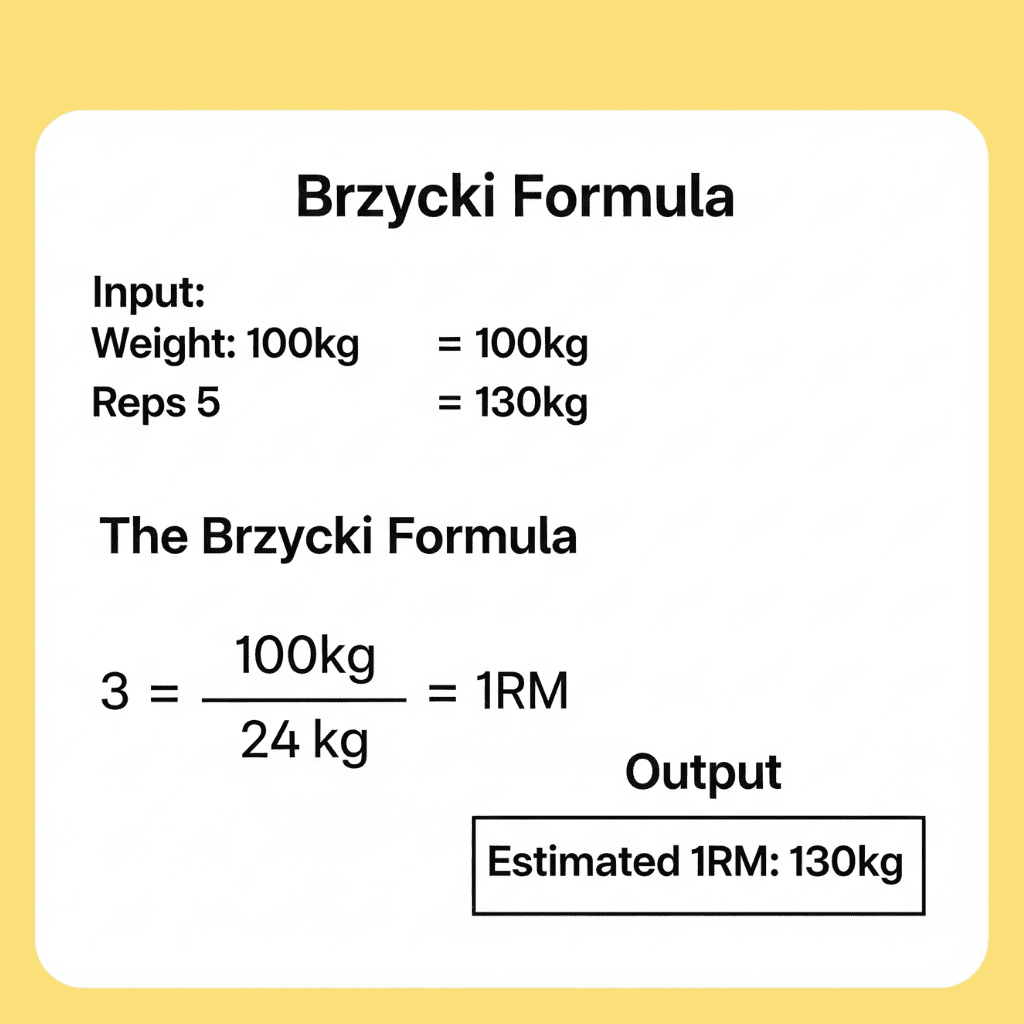For anyone serious about strength training, understanding your one-repetition maximum (1RM) is crucial. It’s the heaviest weight you can lift for a single, full repetition of a given exercise. Knowing this number allows you to tailor your workouts, track progress, and strategically plan for strength gains. However, constantly performing true 1RM tests can be risky and taxing on the body. This is where estimation formulas come into play, and one of the most popular and reliable among them is the Brzycki Formula.
The Brzycki Formula offers a simple yet effective way to estimate your 1RM without the need for a maximal lift. It’s widely used by coaches, athletes, and fitness enthusiasts to determine their strength levels from submaximal efforts, minimizing injury risk while still providing valuable data for program design. This article will dive deep into what the Brzycki Formula is, how it works, its benefits, limitations, and how you can apply it to supercharge your strength journey.
What is the Brzycki Formula?
The Brzycki Formula, developed by Matt Brzycki, is an empirical equation designed to estimate a lifter’s one-repetition maximum (1RM) based on a submaximal lift. Instead of attempting a single, all-out lift, you can perform multiple repetitions with a lighter weight, and then use the formula to calculate your estimated 1RM. This method is particularly beneficial for strength assessment, avoiding the high neurological and physical stress associated with true 1RM testing.
The formula is expressed as:
1RM=(1.0278−0.0278×Number of Repetitions)Weight Lifted
Here’s a breakdown:
- Weight Lifted: This is the amount of weight you successfully lifted for a certain number of repetitions.
- Number of Repetitions: This is the maximum number of reps you could perform with that specific weight until momentary muscular failure or very close to it.
For instance, if you bench pressed 200 pounds for 5 repetitions, you would plug those numbers into the Brzycki Formula to get your estimated 1RM. This calculation provides an estimated 1RM, offering a practical alternative to exhaustive maximal testing.
Why Is Knowing Your 1RM Important?
Understanding your 1RM is more than just a bragging right; it’s a fundamental aspect of effective strength training. It serves as a benchmark for various aspects of your training programs and overall strength gains.
Personalized Training Intensity
Most effective strength training programs are built around percentages of your 1RM. For example, if your goal is hypertrophy, you might train within 60-80% of your 1RM for a higher rep range. If you’re focusing on strength development or powerlifting, you’d work with higher percentages, typically 80-95% of your 1RM, for fewer repetitions. Without an accurate 1RM, setting these training zones becomes a guessing game.
Tracking Progress and Overcoming Plateaus
Your 1RM is a tangible metric for tracking your progressive overload. As you get stronger, your 1RM should increase. Regularly estimating your 1RM allows you to see if your training is effective and helps you identify when you might be hitting a plateau. This knowledge empowers you to make informed adjustments to your routine, whether that means increasing the weight, altering rep schemes, or trying new training techniques.
Enhanced Safety and Injury Prevention
Attempting a true 1RM with incorrect form or insufficient warm-up can lead to serious injury prevention concerns. By using the Brzycki Formula to estimate your 1RM from a submaximal set, you significantly reduce the risk of injury while still gaining valuable insights into your maximal strength. This is especially important for beginners or when working with new exercises.
Goal Setting and Motivation
Having a clear understanding of your current strength levels enables you to set realistic and challenging strength goals. Whether it’s hitting a specific bench press 1RM or improving your squat, these goals can be powerful motivators, driving consistency and dedication in your weightlifting tips and overall fitness journey.
How Does the Brzycki Formula Work? A Step-by-Step Guide

Using the Brzycki Formula is straightforward. Here’s a practical guide on how to implement it:
1. Choose Your Exercise
Select the exercise for which you want to estimate your 1RM. The Brzycki Formula can be applied to various compound movements like the bench press, squat, deadlift, overhead press, and rows. It’s worth noting that its accuracy can vary slightly across different muscle groups and exercises.
2. Warm Up Thoroughly
Before attempting any heavy lifting, a proper warm-up is non-negotiable. This should include some light cardio, dynamic stretches, and several progressively heavier sets of the chosen exercise, gradually increasing the weight but staying well below your maximal effort. For example:
- Set 1: Barbell only for 10-15 reps.
- Set 2: 50% of your estimated working weight for 8-10 reps.
- Set 3: 70% of your estimated working weight for 5-6 reps.
- Set 4: 80-85% of your estimated working weight for 2-3 reps.
This prepares your muscles, joints, and nervous system for the heavier load, optimizing performance and reducing safety considerations.
3. Select a Challenging Submaximal Weight
Choose a weight that allows you to perform between 2 to 10 repetitions with good form until you’re close to muscular failure. The Brzycki Formula is generally considered most accurate within this rep range. Lifting for more than 10 repetitions can introduce more variability and reduce the accuracy of the prediction due to the increased involvement of endurance rather than pure strength.
4. Perform the Repetitions
Lift the chosen weight for the maximum number of repetitions you can complete with strict proper form. It’s crucial that the reps are performed to near failure, but not to the point where your form breaks down significantly. You might want a spotter for safety, especially on exercises like the bench press.
5. Plug the Numbers into the Formula
Once you have your weight and the number of reps performed, simply substitute them into the Brzycki Formula:
1RM=(1.0278−0.0278×Number of Repetitions)Weight Lifted
Example Calculation:
Let’s say you lifted 225 pounds for 6 repetitions on the back squat.
1RM=(1.0278−0.0278×6)225 1RM=(1.0278−0.1668)225 1RM=0.861225 1RM≈261.32 pounds
So, your estimated 1RM for the back squat would be approximately 261 pounds. This calculation example demonstrates how straightforward the process is. For an easy-to-use tool to calculate your 1RM, check out our 1 Rep Max Calculator.
Benefits of Using the Brzycki Formula

The Brzycki Formula offers several compelling advantages for strength athletes and fitness enthusiasts alike.
Reduced Injury Risk
As mentioned, attempting a true 1RM can be risky. The Brzycki Formula allows you to determine your maximal strength without exposing your body to the extreme stress of a single, maximal lift. This is a significant advantage for injury prevention, especially for those who are relatively new to heavy lifting or those returning from injury.
Practicality and Convenience
You don’t need a dedicated “max out” day to use the Brzycki Formula. You can integrate a submaximal test into your regular strength training routine. This saves time and energy, allowing you to focus on your main training goals without constantly peaking for a 1RM test. It’s a highly practical application for daily training.
Effective for Program Design
Knowing your 1RM, even if estimated, is invaluable for designing effective training programs and implementing periodization. You can accurately set percentages for different training goals, such as building explosive power, strength endurance, or maximizing strength gains. Personal trainers often use this formula to craft personalized plans for their clients.
Versatility Across Training Levels
The Brzycki Formula is useful for a wide range of individuals, from beginners learning the ropes of weight training to advanced lifters looking to fine-tune their programming. While beginners may benefit from its safety aspects, advanced lifters can use it for consistent tracking progress and assessing the effectiveness of complex deloading strategies.
Resource Conservation
Maximal lifts are incredibly demanding on the central nervous system. Frequent 1RM attempts can lead to overtraining and hinder recovery. By using the Brzycki Formula, you conserve your physical and neurological resources, allowing for more consistent and productive training sessions.
Limitations and Considerations for Accuracy
While the Brzycki Formula is a powerful tool, it’s essential to understand its limitations to ensure you’re using it effectively and interpreting its results accurately.
Repetition Range Sensitivity
The Brzycki Formula, like most 1RM prediction equations, is most accurate when the number of repetitions used for the calculation is low, typically between 2 and 10 reps. As the number of repetitions increases beyond 10, the accuracy tends to decrease. This is because higher rep sets involve a greater contribution from muscular endurance and different energy systems, making the relationship to a pure maximal strength lift less linear. Some research even suggests it’s best for 10 or fewer reps.
Individual Variability
Every individual is unique. Factors such as muscle fiber composition (the ratio of fast-twitch to slow-twitch muscle fibers), training experience, genetics, and even mental preparation can influence how well a formula predicts a 1RM. What works perfectly for one person might be slightly off for another. This means the formula provides an estimate, not an absolute truth.
Exercise Specificity
While generally applicable, the formula’s accuracy can vary between exercises. It tends to be more accurate for compound lifts like squats, bench presses, and deadlifts compared to isolation exercises. The biomechanics and muscle recruitment patterns differ, which can affect the prediction.
Fatigue and Form Degradation
If the submaximal set is performed with poor form due to fatigue, or if the last few repetitions are “grinded out” with significant technique breakdown, the input data will be compromised, leading to an inaccurate 1RM estimation. Maintaining strict proper form throughout the set is paramount for reliable results.
Comparison to Other Formulas
It’s also helpful to recognize that the Brzycki Formula is one of several 1RM prediction equations, including the Epley Formula, Lander Formula, and Lombardi Formula. Each has slightly different mathematical models and may yield slightly different results. Some lifters find one formula more accurate for them personally or for specific exercises. For example, some find the Epley formula more accurate for training purposes.
Optimizing Your Results with the Brzycki Formula
To get the most out of the Brzycki Formula and make it a truly valuable asset in your training, consider these expert tips and best practices:
Consistency is Key
For the most reliable tracking of progress, use the Brzycki Formula consistently. If you’re using it every 4-6 weeks to reassess your strength, try to use the same exercise, similar rep ranges (ideally 3-6 reps), and ensure consistent rest between sets and warm-up protocols.
Focus on Proper Form
This cannot be stressed enough. An estimated 1RM is only as good as the input data. Prioritize proper form over lifting heavier weight for more reps when performing your submaximal set. If your form breaks down, the set is no longer a true reflection of your strength potential for those repetitions.
Understand the “Estimate”
Always remember that the Brzycki Formula provides an estimate. It’s a valuable tool for guiding your training intensity and tracking progress, but it shouldn’t replace actual 1RM testing (performed cautiously and infrequently) if precise maximal strength numbers are needed for a competition, for example.
Integrate with Your Training Cycle
The Brzycki Formula is particularly useful during different phases of periodization. During accumulation or hypertrophy phases, where you’re typically lifting submaximal weights for higher reps, you can periodically use the formula to gauge your increasing strength without disrupting your training flow. This aids in adjusting progressive overload parameters.
Listen to Your Body
While the formula gives you a number, your body provides invaluable feedback. If the estimated 1RM feels significantly off, or if a particular weight feels too heavy or too light for a given percentage, adjust accordingly. Recovery strategies and adequate nutrition for strength also play a huge role in your daily performance. Don’t push through pain or severe fatigue; these are signs of potential overtraining.
Spotting and Safety
When performing the submaximal set, especially on exercises like the bench press or squat, always prioritize safety. If lifting near failure, ensure you have a reliable spotter or are using a power rack with safety pins in place. Knowledge of spotting techniques is crucial.
Brzycki Formula in Practice: Real-World Applications
Beyond just estimating a single lift, the Brzycki Formula has numerous practical applications for different populations and training goals. For a deeper dive into applying this tool, read How to Use a 1 Rep Calculator to Maximize Your Lifts & Gains.
For Bodybuilders
Bodybuilders often train for muscle hypertrophy, which typically involves moderate to high rep ranges. While they might not frequently test a true 1RM, the Brzycki Formula allows them to periodically check their strength gains in key lifts. This helps ensure they are applying sufficient progressive overload to stimulate muscle growth.
For Powerlifters
While powerlifters ultimately need to perform a true 1RM in competition, the Brzycki Formula can be an excellent tool during their off-season or preparatory phases. It helps them monitor strength without the constant wear and tear of maxing out. It can also assist in selecting appropriate percentages for strength development cycles.
For General Fitness Enthusiasts
For those focused on general fitness, the Brzycki Formula provides a safe and effective way to gauge strength and measure improvements. It helps in setting realistic goals and ensures they are consistently challenging themselves, promoting overall well-being and strength.
For Athletes in Other Sports
Many athletes, from team sports to endurance events, incorporate strength training into their routines. Knowing their 1RM helps coaches design sport-specific strength programs, optimizing for attributes like explosive power and resilience without the need for high-risk max-out sessions.
For Rehabilitation and Return to Sport
In a rehabilitation setting, a patient’s 1RM may be too risky to test directly. The Brzycki Formula allows therapists and coaches to safely estimate maximal strength from submaximal efforts, guiding appropriate loading for recovery and gradual return to activity. This is particularly useful for setting baselines and monitoring progress in a controlled manner.
Frequently Asked Questions About the Brzycki Formula
-
Is the Brzycki Formula accurate for all rep ranges?
While useful across various rep ranges, the Brzycki Formula, like most 1RM estimation formulas, is most accurate when the number of repetitions is 10 or fewer. As the reps increase beyond this, the formula may overpredict or underpredict due to the increased contribution of endurance and different energy systems.
-
Can I use the Brzycki Formula for every exercise?
The Brzycki Formula is generally more reliable for compound exercises (like squats, deadlifts, and presses) that involve multiple muscle groups. Its accuracy might decrease for isolation exercises or those with highly variable technique.
-
How often should I estimate my 1RM using this formula?
The frequency depends on your training goals and experience. For general progress tracking, once every 4-8 weeks can be sufficient. More advanced lifters might do it more often to adjust their periodization schedules, while beginners can use it less frequently to focus on mastering form.
-
What if my estimated 1RM doesn’t feel right?
If your calculated 1RM seems significantly higher or lower than what you intuitively feel your strength is, re-evaluate the input. Did you perform the reps to near failure with good form? Was the rep range appropriate (2-10 reps)? You can also try using another 1RM formula (like the Epley Formula) and compare the results to get a more averaged estimate. Ultimately, listen to your body and adjust your training accordingly.
-
Does gender or age affect the Brzycki Formula’s accuracy?
While some physiological differences exist between genders and age groups (e.g., women’s strength training considerations, older adults strength adaptations), the fundamental relationship between submaximal reps and 1RM generally holds. However, individual variations will always exist. Research indicates the formula can be effective across different populations, including youth strength training, though specific application may be nuanced for each.
Conclusion
The Brzycki Formula stands as a highly valuable and practical tool for anyone engaged in strength training. Its ability to accurately predict your 1RM from a submaximal effort offers a safer, more convenient alternative to traditional maximal testing, significantly reducing injury risk while providing essential data for optimizing your training programs.
By understanding how the formula works, its benefits, and its limitations, you can leverage it to set precise training intensity, effectively track your strength gains, implement progressive overload, and make informed decisions about your strength development. Whether you’re a bodybuilder, powerlifter, or simply aiming for general fitness, integrating the Brzycki Formula into your routine empowers you to train smarter, more safely, and with a clearer path toward achieving your full strength potential.
Are you ready to use the Brzycki Formula to unlock new levels of strength and precision in your training?






